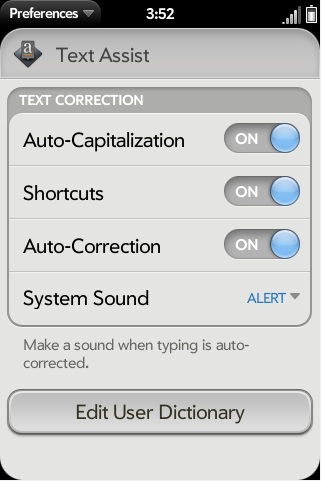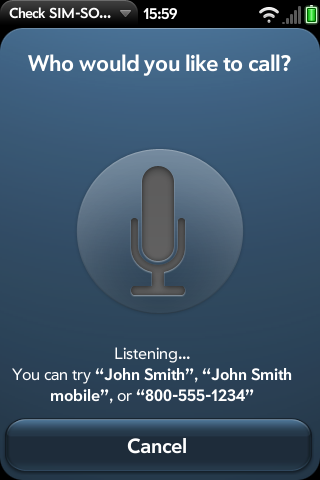webOS 2.0 Overview
by Mithun Chandrasekhar on February 3, 2011 6:05 PM ESTOther Updates
Overall, the UI has been polished up in webOS 2.0. While I cannot comment on the performance because of the non-final software I was running, the transition animations themselves appeared very smooth. HP has also updated certain HTML 5 features supported by webOS and rolled in the popular node.js Javascript framework runtime into webOS 2.0, thereby letting developers come up with their own background services in Javascript, in addition to the applications themselves. There are also a couple of other consumer-facing updates that are worth mentioning.
Although all webOS devices to date (all of two!) have had physical keyboards, spelling correction has been absent in webOS until now. Whether this is because we’ll be seeing keyboard-less webOS devices in the future or because HP thought it would be a good idea to include it anyway, we finally have a spell-check in webOS. Dubbed “Text Assist”, it performs the usual gamut of auto-corrections and lets you enter a list of user defined words.


Text Assist makes its (useful) debut on webOS 2.0
The one nice touch I most definitely appreciate here is the ability for the user to define word shortcuts. The user can now define mappings between shorthand words and how they’re supposed to be auto-corrected. “im” will become “I’m”, “were” will be set to “we’re” etc. where appropriate.
A sorely missing feature in webOS that HP has finally added is voice dial and command. By virtue of this, they have opened up developer access to the device mic. This will certainly bring in a flurry of VOIP apps, with Skype confirming that it will release a version of its app for the webOS platform (although it looks as though it will be restricted to Verizon-only devices, at least initially). This definitely fills a void in the webOS platform that has been open for far too long.



(Left)Voice dial, (Center) Favorites, (Right) dialer app now in blue
The final big update webOS 2.0 brings along with it is the inclusion of Flash 10.1 support. Yes, after multiple “It’s coming soon” promises, this iteration of webOS finally adds Flash support. Now you might be shocked to see this listed way down here, almost towards the end of the article, but there is a reason for this.
As I had mentioned earlier, we didn’t get a Pre 2 device for this article. I made use of the beta webOS 2.0 SDK and a “doctored” version of webOS 2.0 on my Pre Plus. Because of this, I could not get a true representation of the performance of the Flash implementation in webOS 2.0. This was because the SDK would be running on a full-fledged computer and the version of webOS 2.0 I had running on my Pre Plus was definitely not final.
That being said, I could see the all-important banners and short clips without much trouble. However, full-blown Flash videos were definitely choppy, with gesture controls (zoom, scroll etc.) not working. I will put this down to the beta-ness of the build and more importantly the fact that the Pre Plus only has an OMAP 3430 down-clocked to 500Mhz. Because a webOS 2.0 compatible build of Uberkernel is not around yet, I could not see if overclocking the CPU made it better in any way or form.










46 Comments
View All Comments
alxxx - Sunday, February 6, 2011 - link
So is HP eating its own dog food and making its staff use Pre2'sor is it still only half heartedly supporting web os ?
Pre 2 isn't available on any of the 3 major carriers here in Australia
Targon - Sunday, February 6, 2011 - link
HP is not releasing ANYTHING until Feb 9th, so the lack of new devices that you have heard about may be due to keeping things quiet.kmmatney - Sunday, February 6, 2011 - link
I'll always have fond memories of the original Pre. My company is on ATT, and when I was told get my first smartphone, I was specifically told to go to the ATT store and get a crappy $79 Palm "smart " phone. I asked if I could get an iPhone, and they said no - too expensive. So I went to the ATT store, and luckily enough the Pre had just come out on Sprint, and ATT was no longer allowed to sell any Palm smartphones. Woohoo! This allowed me to buy an iPhone instead, and after showing my company that it was only $20 more, it was then an approved phone, allowing all my co-workers to go out and get iPhones. This was back in 2009, so the only smartphones worth getting on ATT were iPhones or Blackberries.commet67 - Wednesday, February 9, 2011 - link
In another era the market would have been iOS and Pre to worthy competitors. The core issue is that Google bought stole and copied a bunch of technologies and gave them away for free with Android. This is called dumping in any other industry - except in this case it wasn't hardware but software. It basically puts all the legitimate Software OS companies out of business - the little guys first - (this is a major part of the US economy and spells doom for other OS developers). If Microsoft didn't have windows and office to fund their mobile division they would be out of business to from Goggle's illegal and unethical ("don't be evil" my a$$!) behavior.Where are the feds to stop Google from killing off our tech industry - it will be Google's free OS (NO Software revenues from the rest of the world to USA - just great for the monster trade deficit) and a bunch of Korean and Taiwanese and future Chinese Hardware makers (again no Hardware revenue to the USA).
Google is killing our future economy and a key growth industry we created. Where is the outrage! - where are the Feds?!
HP is probably too far behind to resuscitate Palm to any substantial market share after Google's illegal between rounds knockout punch - but at least web OS may live to see another day.
(P.S. I ban Android and use iOS)
silentim - Saturday, February 19, 2011 - link
What HP need is its own hardware store. Dont fully trust ISP to market their phone, instead open their own showroom and store and let people try with the hardware. And also more presence in non US market, I mean lot of smart developers does not have access to Nexus S just because they don't live in US. Don't underestimate Asian market, e.g China, Japan, Korea, India, Indonesia, Malaysia, Singapore and Australia. The developers there are desperate to get early access of hardware, while the society just love to buy anything new.And integration with HP laptop, e.g. rather than preinstall the HP laptop with bloatware, why not preinstall it with WebOS SDK? (like Apple always distribute XCode in its software DVD).
I think with only knowledge of javascript, HTML, and CSS to build an app, it should have more developer potential.
Elijahdug - Monday, September 14, 2020 - link
https://bit.ly/2FyoGOs - 100-% МЕТОД РАЗВЕСТИ ДЕВУШКУ НА СЕКС